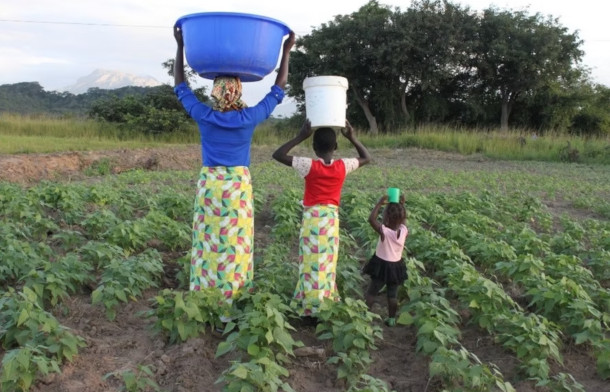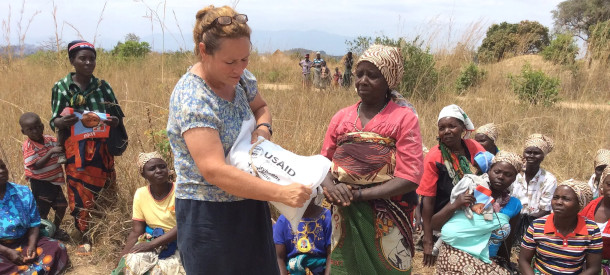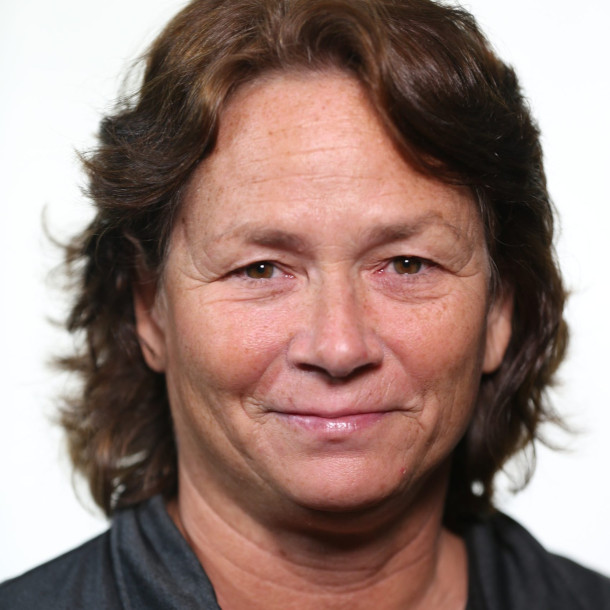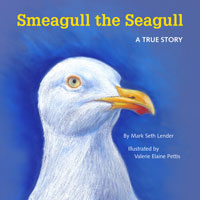US Disrupts African Food Tech
Air Date: Week of June 13, 2025

The Soybean Innovation Lab partners with researchers, farmers, and stakeholders across the private and public sectors to advance the production of soybeans in sub-Saharan Africa. Above, intergenerational farmers stand in a soybean field in Rotanda, Mozambique. (Photo: Soybean Innovation Lab).
One of the development initiatives affected by the Trump Administration’s shutdown of USAID is the Soybean Innovation Lab, which works to improve soybean yields and production in Africa to help boost food supplies and farm income. Kerry Clark runs a mechanization development and fabrication training team at the Soybean Innovation Lab and joins Host Jenni Doering to discuss the work of the lab and why helping improve farmers’ yields is so fulfilling.
Transcript
DOERING: From PRX and the Jennifer and Ted Stanley Studios at the University of Massachusetts, Boston, this is Living on Earth. I’m Jenni Doering.
In recent decades, humanitarian and development aid from the United States has fed the hungry, prevented and cured diseases and lifted people out of poverty around the world. And some say that has made the world a little safer, as well as kinder. But the Trump Administration has signaled it no longer values this “soft power,” and is shutting down the U.S. Agency for International Development or USAID. One of the USAID programs threatened by this decision is the “Feed the Future” Soybean Innovation Lab at the University of Illinois Urbana-Champaign, which works to improve soybean yields and production throughout Africa. These efforts are more important than ever as climate disruption brings worsening droughts, floods and extreme heat. Kerry Clark teaches in the College of Agriculture at the University of Missouri and runs a mechanization development and fabrication training team at the Soybean Innovation lab, and she joins us now. Welcome to Living on Earth, Kerry!
CLARK: Thank you for having me.
DOERING: So, Kerry, how is climate change impacting agricultural development and food security across sub-Saharan Africa?
CLARK: One of the big things that we see in Africa, and you know, I, coming in and out, don't see this, but I hear it from farmers all the time, is that the rain patterns have changed, and the tropics and the subtropics are all monsoonal seasons, so they have rains that come a certain time of year and last for a certain number of months, and that has, in the past, been very reliable. They knew when they were going to come, and it depends on, of course, where you live, when it shows up. And what's happened now is that either the rains come much later, or they come and then they stop, and then they might start again. But what happens is that people, you know, as they grow grain, and let's just take soy for an example, people save that seed and they grow it again next year. So they'll harvest and they have, let's say they have 100 pounds of seed. They're gonna eat 80 of it and save 20 to grow next year. So that 80 pounds, they have to make that last until the following year's harvest. So let's say they take the 20 and they plant it at the beginning of rainy season, and it rains three times and it stops. That seed dies. That's all they saved. Or what happens is, if the rain's delayed, then the 20 that they were saving for seed, they have to eat it before they can even plant it. So you end up, I think we're going to see a lot of hunger in upcoming years because of that seed versus grain issue and trying to make them both last until planting, they get in the ground and the next harvest. With climate change, it really affects people's ability to segregate out seed versus grain for eating and to be able to have seed to save.
DOERING: So why was this soybean lab created, and why focus on soy versus another crop?
CLARK: So there's actually, I think, 23 innovation labs that came under the USAID, and they deal with all sorts of different crops. So there was one for millet, one for sorghum, I think, one for common beans, one in general for legumes, peanut, so there was many, many different innovation labs. Ours was focusing on soybean because soybean is a crop that can be both eaten and sold as a commodity, and it can bring farmers out of poverty because it gives them an important crop to sell. The main market for soy is the poultry industry. And the poultry industry across the world is the fastest growing meat industry, and so soybean is incredibly vital, because unlike common bean or other types of beans, soy has an equivalent level of protein to meat. It's about 40 to 45% protein, while common beans are usually less than 15%. So per acre, you get a huge amount of protein with soybean. We focused on Africa, and we were not introducing soybean to Africa. It's been there for decades. What we were trying to do is get better varieties and get a better value chain and infrastructure system so that people can make more money and be more productive when they do grow soy.
DOERING: And remind me, does soy actually help fix nitrogen in the soil?
CLARK: Yes, soy is a legume. Yes, soy is a legume. It's a very high nitrogen fixer. So it's just like common bean or pigeon pea, or some things like that. The common beans tend to be more women's crops and grown for food for the family. They're not a commodity, being one that someone sells for a profit. So the soy is a commodity crop, so people can actually make money, and it can help build wealth. And that's one of the reasons USAID was focusing on that, because it has been a wealth builder across the world. If you look at what's happened to Brazil since Brazil stepped into the soy market, you know their income has greatly increased. Now, soy has a bad rap in Brazil, because people are basically cutting down the rainforest to grow soy. That's not soy's problem. I mean, that's not soy's fault. That's just because people wanted a crop that makes money. And so it doesn't matter if it's soy or corn or anything, but what they found was that they could grow soy well in Brazil. And so that's why it is soy, but it could have been any crop. In Africa, a lot of the arable land is, of course, already under production, but it's not very productive. Part of the problem in Africa is the age of the soil. It's the most weathered soil in the world, very low in nutrients that crops need, and soy has done well there compared to a lot of other crops like maize that are not indigenous. But the problem is their yield is about a fifth of its potential. And so that was what we were working on. Like, if you're gonna put the effort and use the land, then it's better that you get a higher yield.

Ongoing projects at the Soybean Innovation Lab include the testing of different soybean varieties in an effort to increase crop productivity. Our guest, Kerry Clark, says the current soybean yield is only about one fifth of its potential in sub-Saharan Africa. (Photo: Soybean Innovation Lab)
DOERING: That's incredible, that there was, 20%, a fifth of the yield that they could have if they were to employ some of these techniques?
CLARK: Yes. And we're not throwing inputs at this. Some of it's just, you know, even biological and like, the biggest thing we found was that people were getting very low yields because they weren't putting the plants close enough together. So we had a lot of production, agronomic things that we were able to influence that increased yield a lot that didn't require any inputs, just a different way of doing things. So some of the inputs that are important for soy is like rhizobium inoculant, and there are some places in Africa where they produce that. It's a very, very low cost input. It's just something that they grow, basically, you grow the inoculant and then you package it and sell it to farmers, and it makes a big difference.
DOERING: And just so people understand, I think you're talking about a bacteria?
CLARK: Yes, there's bacteria that live naturally in the soil that will have a symbiotic relationship with plants, and the plant provides the bacteria with carbohydrates that it gets from photosynthesis. And the carbohydrates are used for energy, just like us. We need carbs for energy. And then the bacteria, and for the case of soybean, it's called bradyrhizobium, that bacteria can utilize nitrogen from the atmosphere and put that into the plant roots, and then the plant, basically, we say the plant's making its own nitrogen, but in reality, it's a bacteria that's on the root that's providing the nitrogen from the atmosphere for the plant. And the plants need nitrogen for growth, because that's what amino acids and proteins come from, nitrogen.
DOERING: And Kerry, what does your work with the Soybean Innovation Lab involve?
CLARK: My part, of course, was the mechanization. So when we first got to start working with soy in Africa, and I think it was around 2013, 2014, we got a lot of feedback from farmers that said, we like soy, we make money with soy, but it's very, very hard to harvest, and most crops in Africa are hand-planted and hand-harvested still. And so we found some very good designers and fabricators in Ghana, and worked with them to develop a thresher that would process soybeans very rapidly. And we've done trainings all across the African continent on that from 2018 to 2020, and we've worked with the private sector to build manufacturing, and that's one of the big problems in Africa, is that manufacturing and the industrial sector is very limited, and so we've always focused on local manufacturing. Right before the USAID was terminated, we started increasing the number of designs that we had available, and we’d provide these free of charge to local manufacturers across the African continent. We do the original field testing of the design and give them feedback and input on what kind of farmers or what kind of crops each thing can be used for. But we've increased our product line to, we had just the thresher, and now we have a planter and also a pull-type combine. And that's kind of when we lost our funding. And so that pull-type combine was actually invented by a small farmer in Virginia, a man named Alexis Ziegler. And although it's patented, he's made it available for manufacturing in Africa. And so that was where we were heading when we lost funding.
DOERING: You had a lot of really exciting things in the works, it sounds like.
CLARK: Yes, we were having a lot of impact. So one of the goals of development is you always want to work yourself out of a job. So you want to build capacity where you're working, so that when you're gone and when the funding dries up, they can continue it. So we hadn't quite reached the point where they were completely independent of us. A few more years would have helped a lot. But I think Africa is heading in that direction, and it's very unfortunate now that the US has withdrawn funding for those kind of things.
DOERING: So what have you been hearing from farmers and communities about these cuts and how they're impacting their efforts to grow soy?

Kerry Clark provides training to soybean success kit recipients in northern Ghana. Clark says resources such as these kits can be “life-changing” in terms of creating income within African communities. (Photo: Soybean Innovation Lab)
CLARK: I mean, this is all pretty fresh, you know, the USAID cuts just came this spring. But immediately, you know, we lost all funding, people are still growing soy, but really quickly, they're going to find out now that they don't have access to the newest varieties, they don't have access to testing of inputs. Now, we had been working with the International Institute of Tropical Agriculture, and they had been doing a lot of things with soy, and they will continue to do things with soy, but they were also funded a lot by USAID, and so it will also affect their efforts. So, this year for farmers in Africa, there's still varieties available, things are still the same, but next year they're going to see the effect that processes are going to have problems, the farmers are going to have problems, the input providers, everybody's going to have problems. And we've seen it here in the United States as well, that with the elimination of USAID, we have had huge cuts to Food for Progress and McGovern-Dole feeding programs and, you know, various programs that bought U.S. commodities and exported them through these USAID programs. So farmers are going to see effects in the United States. They're going to see it in Africa. That's the development side of USAID, but what's really devastating was the humanitarian aid side, where people are already dying. You know, they provided money for AIDS drugs, for malaria drugs, for a lot of medical vaccination, for research, for actually buying the drugs, and then, of course, USAID was also using a lot of that food that they bought in the United States to support feeding programs and refugee camps, and they supported the World Food Program, which is the biggest program for feeding people across the world. And that's all gone, and so that's going to cause, you know, very immediate suffering and death, and already has.
DOERING: So Kerry, what's next for you?
CLARK: So, we're trying to keep the Soybean Innovation Lab going, as well as we can. So basically, we're targeting people that have certain needs, and we're saying, we can meet your need, but because we don't have USAID funding, you may have to pay something to get this. I think all of us are kind of like, I won't be taking a paycheck for this. I'm doing it because I believe it's the right thing to do and people need it. So I've worked in research and extension in the United States for, I guess, 40 years now, and American farmers have it pretty good. They have very good processes. They have great machinery. They know what needs to happen. And so they don't really rely on the universities quite like they did maybe in the 40s and 50s when we brought in, hybrid corn and things like that. But in Africa, I can do just this teeny, little, smallest thing, and it can affect an entire village positively, like I might double their income because I told them to do something that they didn't realize would affect yields or growth. So I do it because of that. I don't need to draw an income. I need people to benefit from my expertise that I got the advantage of having, having been born, raised and educated in the United States.
DOERING: It must feel really good to be able to help so many people like that.

Kerry Clark teaches in the College of Agriculture, Food and Natural Resources at the University of Missouri and leads the Mechanization Division for the Soybean Innovation Lab. (Photo: University of Missouri)
CLARK: Yeah, I mean, when we taught people how to build this thresher, and then people started building them in areas where nobody had been growing soybeans, suddenly they started growing it, and now they have income because they can sell those soybeans to the poultry processors. You know, what's a drop in a bucket here can be life-changing in Africa, as far as providing knowledge or, you know, a piece of equipment or a new seed variety or something.
DOERING: Kerry Clark, PhD, runs a mechanization development and fabrication training team that includes three equipment designers from Ghana at the Soybean Innovation Lab. Thanks so much for joining us.
CLARK: Thank you for having me.
DOERING: Regarding its plans to shut down USAID, a recent State department cable reads, “The Department of State is streamlining procedures under National Security Decision Directive 38 to abolish all USAID overseas positions.” It also says the department “will assume responsibility for foreign assistance programming previously undertaken by USAID” as of June 15th. The Soybean Innovation Lab did receive some good news after the USAID cuts were announced. An anonymous donor offered roughly $1 million to help the Soybean Innovation Lab continue some of its work on a smaller scale for one more year. You can find out more on the Living on Earth website, loe.org.
Links
Inside Climate News | “USAID-Funded Soybean Lab Gets Lifeline After Cuts”
Living on Earth wants to hear from you!
Living on Earth
62 Calef Highway, Suite 212
Lee, NH 03861
Telephone: 617-287-4121
E-mail: comments@loe.org
Newsletter [Click here]
Donate to Living on Earth!
Living on Earth is an independent media program and relies entirely on contributions from listeners and institutions supporting public service. Please donate now to preserve an independent environmental voice.
NewsletterLiving on Earth offers a weekly delivery of the show's rundown to your mailbox. Sign up for our newsletter today!
 Sailors For The Sea: Be the change you want to sea.
Sailors For The Sea: Be the change you want to sea.
 The Grantham Foundation for the Protection of the Environment: Committed to protecting and improving the health of the global environment.
The Grantham Foundation for the Protection of the Environment: Committed to protecting and improving the health of the global environment.
 Contribute to Living on Earth and receive, as our gift to you, an archival print of one of Mark Seth Lender's extraordinary wildlife photographs. Follow the link to see Mark's current collection of photographs.
Contribute to Living on Earth and receive, as our gift to you, an archival print of one of Mark Seth Lender's extraordinary wildlife photographs. Follow the link to see Mark's current collection of photographs.
 Buy a signed copy of Mark Seth Lender's book Smeagull the Seagull & support Living on Earth
Buy a signed copy of Mark Seth Lender's book Smeagull the Seagull & support Living on Earth

